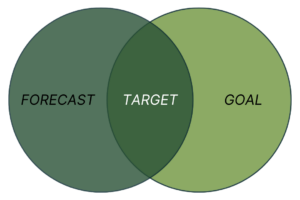Forecast Series Part 1 (of 4)
The Strategic Edge for Ecommerce Managers: Aligning Forecasts with Goals to Create Achievable Targets
As an ecommerce manager, you’re not just chasing revenue numbers—you’re expected to bridge the gap between ambition and reality. Leadership counts on you to turn data into direction. But often, the tools and resources at your disposal don’t match the expectations on your plate.
Sound familiar? Whether you’re managing ambitious growth goals or navigating stagnant market conditions, your ability to align forecasts with goals can make or break your success. In this post, we’ll highlight how you can use data as your ally to create clarity, build trust, and inspire action across your organization.
The Challenge: When Goals and Realistic Forecasts Clash
Let’s start with two scenarios that might hit close to home:
- Scenario 1: You’ve been handed a 30% growth goal with no additional budget or explanation. Now you’re left figuring out how to make magic happen without the resources you need.
- Scenario 2: Your industry isn’t growing, yet leadership expects a 10% increase next year. How do you convince them to set realistic expectations—or better yet, give you the tools to hit those ambitious targets?
If these situations resonate, you’re not alone. Ecommerce managers everywhere face the same uphill battle of reconciling aspirational goals with operational realities. The key to pushing back effectively—or rallying your team to overdeliver—lies in creating alignment between goals and forecasts.
Forecasting vs. Goal Setting: A Fine Balance
At its core, forecasting is about defining what’s likely to happen based on data. Goal-setting, on the other hand, reflects your organization’s aspirations—what you want to happen. The challenge lies in bridging the gap between grounded projections and ambitious desires. However, the power lies in bringing together an stretch goal and the reality of a forecast to create a “target,” that will push a team to reach their potential, and also feel achievable to help generate motivation. Target, (also referred to as target goal or target forecast) is how we denote that the goal and forecast have been brought together into a powerful hybrid.

This isn’t just about throwing down aggressive numbers to impress leadership. It’s about managing expectations with clarity, realism, and confidence. The most effective leaders don’t sandbag their goals or oversell potential outcomes—they paint a clear picture of possibilities, supported by data and thoughtful analysis.
Here’s how you can do the same.
Navigating Expectations: The Art of Realistic Optimism
When speaking with investors or leadership teams, your aim isn’t perfection—it’s predictability. A leader who presents nuanced, well-informed projections inspires trust and credibility. Start by framing the conversation around these key principles:
- Transparency Matters
Acknowledge challenges and provide context for your projections. This isn’t about defending past performance—it’s about building confidence in your process. - Reframe Success
Growth isn’t always about revenue surges. Depending on market conditions, success might mean maintaining market share, achieving operational efficiencies, or securing long-term value. - Provide Depth
Instead of a single prediction, present multiple scenarios: best case, most likely case, and conservative case. Explain the drivers behind each one, showing your strategic understanding of market dynamics.
These conversations aren’t just about reporting numbers. They’re an opportunity to position yourself as a forward-thinking leader who uses data to shape the company’s direction.
Crafting a Data-Driven Narrative
A strong target forecast is more than a static document—it’s a strategic roadmap. To build momentum and credibility, ensure your projections are detailed and actionable:
- Break Down Revenue Targets by Sales Channel
Assign ownership for direct-to-consumer ecommerce, Amazon, retail, and wholesale. This granularity provides clarity and accountability across teams. - Account for Operational Realities
Consider factors like price changes, supply chain risks, and shipping costs. Addressing these variables upfront builds flexibility into your forecast and avoids surprises. - Align Definitions Across the Organization
Nothing erodes trust in data faster than conflicting numbers. For instance, if one department pulls revenue data from the ERP system and another from Shopify or Google Analytics, discrepancies can arise. Ensure everyone is aligned on what constitutes key metrics like revenue, taxes, and shipping costs. - Use Visual Tools to Tell the Story
Present historical trends, growth scenarios, and clear drivers visually. This makes it easier for stakeholders to understand the “why” behind your projections.
By taking these steps, you’ll not only create a more reliable forecast but also position yourself as a strategic leader within your organization.
Continuous Evolution: Making Forecasts Dynamic
Forecasting isn’t a one-and-done exercise. It’s a living process that should evolve with market conditions and business priorities. Regularly review and adjust your projections to reflect new information, and don’t be afraid to pivot when necessary.
- Establish quarterly checkpoints to ensure your target forecasts remain relevant.
- Embed flexibility into your process to account for unexpected changes.
- Use your forecast as a collaborative tool to align your team and leadership around shared goals.
When forecasting becomes a dynamic, ongoing exercise, it transforms from a task into a strategic advantage.
The Mindset Shift: From Metrics to Meaningful Impact
Forecasting is no longer about predicting the future with absolute certainty. Instead, it’s about creating a roadmap that guides your organization’s growth. The best ecommerce leaders don’t just present numbers—they use forecasting as a tool to articulate vision, manage risks, and inspire action.
Your goal is simple: transform forecasts from static documents into dynamic strategies that drive meaningful outcomes. By aligning goals with data and presenting them with confidence, you’ll build trust, secure resources, and drive results.
What’s Next?
In the next blog post in this series, we’ll dive deeper into the building blocks of a solid forecast.
Stay tuned—and get ready to level up your forecasting game!

